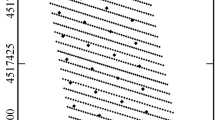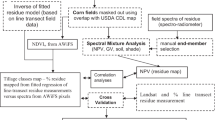Abstract
In production systems where high-resolution harvest data are unavailable there is often a reliance on ancillary information to generate potential management units. In these situations correct identification of relevant sources of data is important to minimize cost to the grower. For three fields in a sweet corn production system in central NSW, Australia, several sets of high-resolution data were obtained using soil and crop canopy sensors. Management units were derived by k-means classification for 2–5 classes using three approaches: (1) with soil data, (2) with crop data and (3) a combination of both soil and crop data. Crop quantity and quality were sampled manually, and the sample data were related to the different management units using multivariate analysis of variance (MANOVA). The corrected Akaike information criterion (AICc) was then used to rank the different sources of data and the different orders of management units. For irrigated, short-season sweet corn production the management units derived from the crop canopy sensor data explained more variation in key harvest variables than management units derived from an apparent soil electrical conductivity (ECa) survey or a mixture of crop and soil sensor data. Management units derived from crop data recorded just prior to side-dressing outperformed management units derived from data recorded earlier in the season. However, multi-temporal classification of early and mid-season crop data gave better results than single layer classification at any time. For all three fields in this study, a 3- or 4-unit classification gave the best results according to the information criterion (AICc). For growers interested in adopting differential management in irrigated sweet corn, investment in a crop canopy sensor will provide more useful high-resolution information than that in a high-resolution ECa survey.

Similar content being viewed by others
Notes
The soil sensors and canopy reflectance sensors used were chosen based on their availability to the researchers. Their use does not imply a specific endorsement for these sensors from the authors who acknowledge there are several other sensors capable of providing equivalent ECa and canopy reflectance data.
References
Aggelopoulou, K. D., Wulfsohn, D., Fountas, S., Gemtos, T. A., Nanos, G. D., & Blackmore, S. (2010). Spatial variation in yield and quality in a small apple orchard. Precision Agriculture, 11, 538–556.
Akaike, H. (1973). Information theory and an extension of the maximum likelihood principle. In B. N. Petrov & F. Csaki (Eds.), Second international symposium on information theory (pp. 267–281). Budapest, Hungary: Akademiai Kiado.
Boydell, B. C., & McBratney, A. B. (1999). Identification and stability of potential within-field yield zones obtained from 11 years of cotton yield estimates derived from mid-season Landsat MS imagery. In J. V. Stafford (Ed.) Precision Agriculture ‘99: Proceedings of the 2nd ECPA (pp. 331–342). Sheffield, England: Sheffield Academic Press.
Bulcock, H. H., & Jewitt, G. P. W. (2009). Improved spatial mapping of leaf area index using hyperspectral remote sensing for hydrological applications with a particular focus on canopy interception. Hydrology and Earth Systems Sciences Discussions, 6, 5783–5809.
Castrignano, A., Guastaferro, F., De Benedetto, D., Moneta, A., Basso, B., Troccoli, A., et al. (2009). Delineation of site-specific management zones using geostatistics and fuzzy clustering analysis. In E. J. van Henton, D. Goense, & C. Lokhorst (Eds.), Precision Agriculture ‘09: Proceedings of the 7 th ECPA (pp. 537–544). Wageningen, The Netherlands: Wageningen Academic Publishers.
Cox, M. S., & Gerard, P. D. (2007). Soil management zone determination by yield stability analysis and classification. Agronomy Journal, 99, 1357–1365.
Cupitt, J., & Whelan, B. M. (2001). Determining potential within-field crop management zones. In G. Grenier & S. Blackmore (Eds.), Proceedings of the 3 rd European conference on precision agriculture (pp. 7–12). Montpellier, France: agro-Montpellier ENSAM.
Fridgen, J. J., Kitchen, N. R., & Sudduth, K. A. (2000). Variability of soil and landscape attributes within sub-field management zones. In P. C. Robert, R. H. Rust, & W. E. Larson (Eds.), Precision Agriculture: Proceedings of the 5th international conference on precision agriculture (p. 16), Madison, WI, USA (Published on CDROM).
Fridgen, J. L., Kitchen, N. R., Sudduth, K. A., Drummond, S. T., Wiebold, W. J., & Fraisse, C. W. (2004). Management zone analyst (MZA): Software for sub-field management zone delineation. Agronomy Journal, 96, 100–108.
Friedman, S. P. (2005). Soil properties influencing apparent electrical conductivity: A review. Computers and Electronics in Agriculture, 46, 45–70.
Frogbrook, Z. L., & Oliver, M. A. (2007). Identifying management zones in agricultural fields using spatially constrained classification of soil and ancillary data. Soil Use and Management, 23, 40–51.
Hurvich, C. M., & Tsai, C.-L. (1989). Regression and time series model selection in small samples. Biometrika, 76, 297–307.
Lark, R. M. (2001). Some tools for parsimonious modelling and interpretation of within-field variation of soil and crop systems. Soil Tillage Research, 58, 99–111.
Lark, R. M., & Stafford, J. V. (1997). Classification as a first step in the interpretation of temporal and spatial variability of crop yield. Annals of Applied Biology, 130, 111–121.
Lizaso, J. I., Boote, K. J., Cherr, C. M., Scholberg, J. M. S., Casanova, J. J., Judge, J., et al. (2007). Developing a sweet corn simulation model to predict fresh market yield and quality of ears. Journal of the American Society for Horticultural Science, 132, 43–283.
Manfrini, L., Taylor, J. A., & Corelli Grappadelli, L. (2009). Spatial analysis of the effect of fruit thinning on apple crop load. European Journal of Horticultural Science, 74, 54–60.
Martin, N., Bollero, G., Kitchen, N. R., Kravchenko, A. N., Sudduth, K., Wiebold, W. J., et al. (2006). Two classification methods for developing and interpreting productivity zones using site properties. Plant and Soil, 288, 357–371.
Martin-Prevel, P., Gagnard, J., Gautier, P., Benton Jones, J., & Holmes, M. R. J. (1984). Plant analysis as a guide to the nutrient requirements of temperate and tropical crops. New York: Lavoisier Publishing Inc.
McQuarrie, A. D. R., & Tsai, C.-L. (1998). Regression and time series model selection. Singapore: World Scientific Publishing Co. Pty. Ltd.
Minasny, B., McBratney, A. B., & Whelan, B. M. (2005). VESPER version 1.62. Sydney: Australian Centre for Precision Agriculture. Accessed September 10, 2010, from http://www.usyd.edu.au/agriculture/acpa/software/vesper.shtml.
Pedroso, M., Taylor, J. A., Tisseyre, B., Charnomordic, B., & Guillaume, S. (2010). A segmentation algorithm for the delineation of management zones. Computers and Electronics in Agriculture, 70, 199–208.
Ping, J. L., Green, C. J., Bronson, K. F., Zartman, R. E., & Dobermann, A. (2005). Delineating potential management zones for cotton based on yields and soil properties. Soil Science, 170, 371–385.
R Development Core Team. (2008). R: A language and environment for statistical computing. R Foundation for Statistical Computing, Vienna, Austria. ISBN 3-900051-07-0, URL: http://www.R-project.org.
Reuter, D. J., & Robinson, J. B. (1997). Plant analysis: An interpretation manual (2nd ed.). Collingwood, Victoria: CSIRO Publishing.
Schumann, A., Hostler, K. H., Miller, W. M., & Zaman, Q. (2004). Sensor-based automatic yield monitoring for manually harvested citrus. American Society of Agricultural Engineers Annual International Meeting, August. Paper No. 041098. St. Joseph, Michigan: ASAE, p. 13.
Taylor, J. A., Hedges, S., & Whelan, B. M. (2009). How long should your corn cob pipe be? Modeling yield*quality interactions in Sweet corn. In A. Bregt, S. Wolfert, J. E. Wien, & C. Lokhorst (Eds.), EFITA conference ‘09: Proceedings of the 7 th EFITA conference (pp. 411–417). Wageningen, The Netherlands: Wageningen Academic Publishers.
Taylor, J. A., Hedges, S., & Whelan, B. M. (2010). A short communication on the spatial variability of production in sweet corn (Zea mays var. rugosa). New Zealand Journal of Crop and Hortiulture Science, 38, 225–231.
Taylor, J. A., McBratney, A. B., & Whelan, B. M. (2007a). Establishing management classes for broadacre grain production. Agronomy Journal, 99, 1366–1376.
Taylor, J. A., Praat, J.-P., & Bollen, A. F. (2007b). Within-orchard spatial variability in kiwifruit quality and implications for fruit quality sampling. HortScience, 42, 1–5.
Tucker, C. J. (1979). Red and photographic infrared linear combinations for monitoring vegetation. Remote Sensing of Environment, 8, 127–150.
Whelan, B. M., & McBratney, A. B. (2003). Definition and interpretation of potential management zones. In Australia “Solutions for a better environment”: Proceedings of the 11 th Australian agronomy conference. Australian Society of Agronomy, ISBN 0-9750313-0-9 (Published on CDROM).
Acknowledgments
The project data used was facilitated by HAL in partnership with AUSVEG. The Australian Government provides matched funding for all HAL’s R&D activities. The authors would like to thank Mr J McSpedden for assistance and access to the production system. Dr Taylor’s position at INRA is funded by the Agropolis Foundation, France.
Author information
Authors and Affiliations
Corresponding author
Rights and permissions
About this article
Cite this article
Taylor, J.A., Whelan, B.M. Selection of ancillary data to derive production management units in sweet corn (Zea Mays var. rugosa) using MANOVA and an information criterion. Precision Agric 12, 519–533 (2011). https://doi.org/10.1007/s11119-010-9195-0
Published:
Issue Date:
DOI: https://doi.org/10.1007/s11119-010-9195-0




